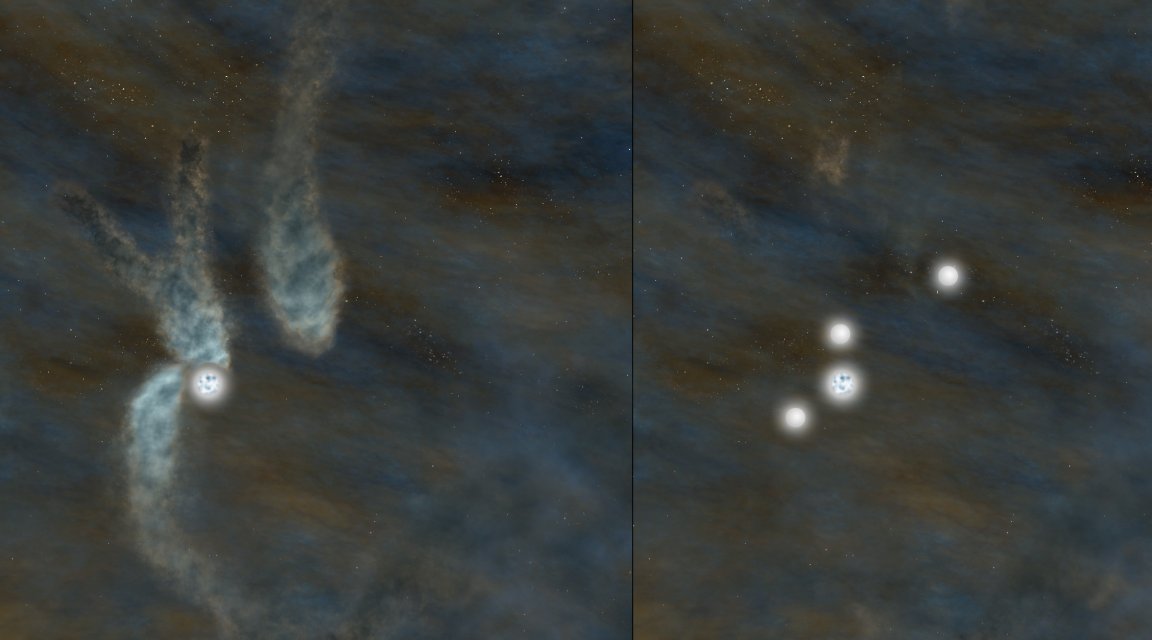

The Sun may ride solo, but the idea that it might have a companion certainly isn’t new. Indeed, taking it a step further, astronomers have long suggested that multiple star systems far outnumber singles, at least as far as medium to high-mass bodies go — in fact, the nearest planetary system from our Sun, called Alpha Centauri, contains not one, or even two, but three stars (Alpha Centauri A and B, and Proxima Centauri), all lurking just 4 light-years from Earth.
Now, in what’s sure to be a game changer, an international team of researchers have, for the very first time, seen the first light of a quadruple star system — that is, a baby solar system with four very young, still-forming stars — toward the constellation of Perseus. They describe the stellar nursery as a filamentary gas cloud with ‘widely separated fragments,’ which was unexpected.
The stars forming within the cloud are so young, in fact, that only one of them has fully progressed beyond the first developmental phase; the other three haven’t yet severed their ties to the nebular cloud from which they sprang. Currently, they are still in the process of condensing and coalescing under the force of gravity, which won’t come to a conclusion for at least another 40,000 years (by some estimates).
Once they emerge from the stellar womb, they will likely come out rather small, weighing only a tenth of the mass of the Sun. What’s more is that each of them will be separated by over a thousand AU (one AU is the average distance between Earth and the Sun).
Future Dynamics:
Using the same calculations, the researchers came to the conclusion that two of the stars — those that are separated by the least distance — will ultimately settle into a stable binary system, while the other two won’t remain a pair for very long. As Jaime Pineda — one of the paper’s co-authors, who hails from the Max Planck Institute for Extraterrestrial Physics — describes: “Star systems with more than three members are unstable and prone to interference,” probably in just half a million years, it will be plucked from its henhouse and catapulted off into interstellar space, leaving its three partners behind.

That’s not the only fascinating thing the researchers learned about this system; its stars also appear to be forming much faster than expected (it’s difficult coming up with a dependable timetable, given the fact that it largely depends on mass, those on the larger end of the spectrum can take over 100,000 years to form, while sun-like stars take much more time). Pineda also notes that this is the first time we’ve seen a multiple star system arise from a ‘fragmented gas cloud.’ “At first, we thought that the fragments wouldn’t interact with each other. Often, only a triple system would form,” she says.
Other notes in the press release:
Pineda is member of a research collaboration that observed the star system and simulated its genesis and demise. At the time of the discovery, he was working as a postdoctoral researcher in Professor Michael Meyer’s group at the ETH Zurich Institute of Astronomy, as was co-author Richard Parker, who determined the stability of the star system on the computer. Astrophysicists from several US and European universities, including Harvard, Yale, Manchester and Liverpool John Moores universities, were also involved in the project. The researchers made their observations at the Very Large Array in the US, which they used to detect emissions originating from ammonia molecules (NH3) in the gas cloud.
“Multiple star systems are very common in our galaxy,” says Michael Meyer, professor at the Institute for Astronomy at ETH Zurich. Most researchers, however, have concentrated on the birth and development of individual stars as this is more straightforward. On the other hand, scientists who analyse multiple systems usually tend to focus more on the end result of the star formation. For this reason, this discovery is something very special.
[Reference: ETH Zurich]
For more information, you can find the full press release here.